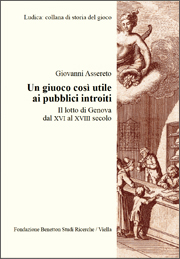
«Un giuoco così utile ai pubblici introiti»
Il lotto di Genova dal XVI al XVIII secolo
[A game to boost public revenues. The Genoese lottery from the XVI to the XVIII century]
by Giovanni Assereto
Fondazione Benetton Studi Ricerche-Viella
Treviso-Rome 2013
136 pages
20 euros
(Ludica, 12)
In 1576 the so-called Leges novae, the legislative measures that were to regulate the institutions of the Republic of Genoa until 1797, ordained that twice a year the names of the five patricians who would replace the five retiring members of the Serenissimi Collegi, highest-ranking organ of government, were to be drawn by lot. According to well-established tradition in Italy and in the rest of Europe the occasion offered an excellent opportunity for betting on the outcome; but in the case of Genoa the procedure soon took an unusual form. An organization was set up to provide systematic management of the wagers, and the way it chose to administer the practice consituted the first model of the game of lotto.
After a period of semi-clandestine control, in 1644 the Republic decided to make the game legal and contract its management out to the highest bidder. From then on the popularity of the Genoese lottery (or rather of the Seminario, as it was called in Genoa after the name of the urn from which the names were drawn) grew constantly in Genoa and in the rest of Italy; and the revenues accruing to the State rose continually too, as the game attracted investments from the leading patrician families.
As time went on there were attempts in Rome, Naples, Venice, Turin and in other cities – albeit often accompanied by moral scruples and concerns – to copy the organization of the game so as to generate similar public and private profits. Such initiatives apparently threatened the interests of the contractors and of the government of Genoa, but behind them, well out of sight, there was usually an enterprising subject of the Genoese Republic or even the contractors themselves, hoping to expand their business. In the long run, however, the Ligurian monopoly was destined to dwindle and disappear, especially as the game spread into other European countries.
Though the Genoese origins of lotto have long been known, this book uses the results of new documentary and archival research to examine for the first time the earliest mechanisms of the game, how contracts to run it were awarded, the plans to reproduce its success outside Genoa and the economic and institutional consequences it gave rise to, some of which were decidedly curious and unexpected.
Contents
Premessa
I. Un atto di nascita insieme certo e confuso
II. Dalla proibizione allo sfruttamento
III. Le regole del gioco
IV. Un prodotto d’esportazione
V. I genovesi e i «lotti forastieri»
VI. La concorrenza interna, l’evoluzione del gioco, gli anni di crisi e di ripresa
Abbreviazioni
Bibliografia
Indice dei nomi di persona e di luogo
Giovanni Assereto (Savona, 1946) teaches Modern History at the University of Genoa and is Director of the post-graduate school of “Regional cultures and societies”. His main fields of research include: modern and contemporary Tuscany, the phenomenon of the poor and welfare policies in Italy and the rest of Europe and the political, economic and social history of Liguria between the XVI and XX centuries. With Marco Doria he recently edited Storia della Liguria for the publishers Laterza; and with Nicola Calleri he edited an anthology of the writings of Giovanni Rebora (Tagli scelti. Scritti di cultura materiale e gusto mediterraneo) for the publishers Slow Food. His «Per la comune salvezza dal morbo contagioso». I controlli di sanità nella Repubblica di Genova, came out in 2011.
